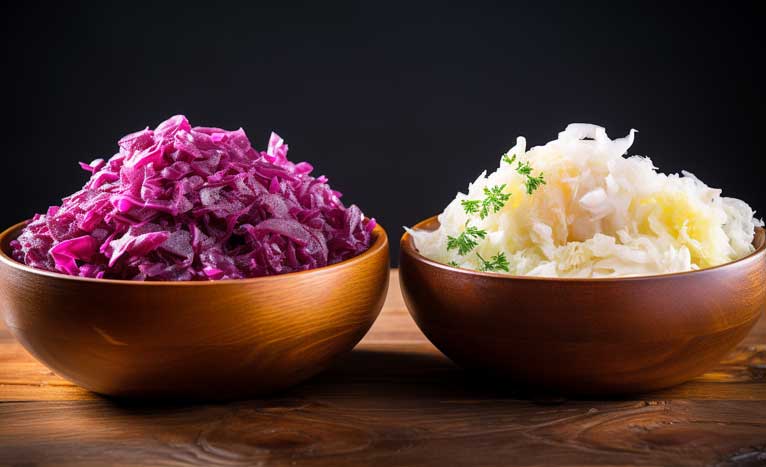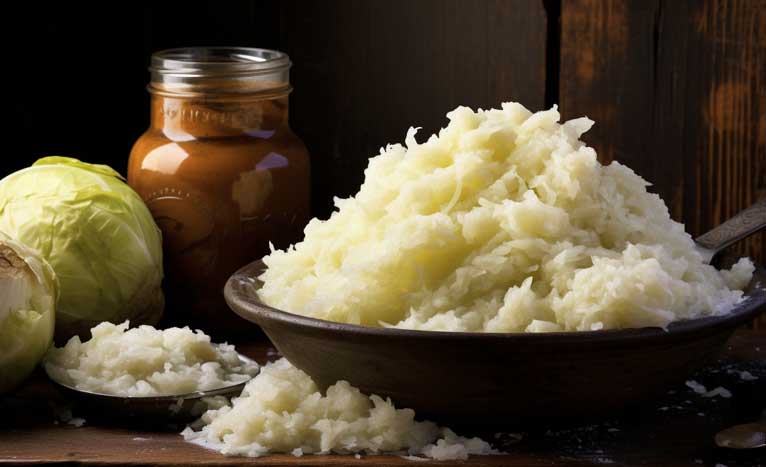In the world of culinary delights, few dishes have stood the test of time quite like sauerkraut, the tangy and crunchy pickled cabbage. Whether you're a fan of its sour punch or its versatility in various recipes, sauerkraut holds a special place in the hearts of food enthusiasts. This blog will dive into the world of sauerkraut, exploring its history, health benefits, and my easy homestead sauerkraut recipe that will surely tickle your taste buds.
If you follow along, you know I love fermented foods because of their health benefits. We aren’t really taught about fermented foods in nutrition class, and they are the ultimate gut microbiome food!

The History of Sauerkraut
Sauerkraut, which means "sour cabbage" in German, has its roots in Eastern Europe, where it has been a staple for centuries. Initially, sauerkraut was created as a way to preserve cabbage during long winters when fresh vegetables were scarce.
Health Benefits of Sauerkraut
Probiotic Powerhouse
Sauerkraut is renowned for its probiotic content, which promotes a healthy gut flora. When cabbage meets salt and the fermentation dance begins, lactobacilli and other beneficial microorganisms come to life. These probiotics make our sauerkraut not just tasty but also incredibly good for our digestive system.
This homestead staple is a great addition to your diet if you're looking to improve your digestive health. Now, when it comes to preserving the harvest and nourishing the body, sauerkraut is a top pick in my homestead kitchen. Fermenting cabbage not only extends its shelf life but also boosts its nutritional profile. You see, during the fermentation process, beneficial bacteria, like lactobacilli, flourish and work their magic. These good microbes aid in digestion, promoting a healthy gut and better absorption of nutrients. Ah, the wisdom of our ancestors was on to something.
Rich in Vitamins
Sauerkraut is loaded with vitamins C and K, essential for strong bones and a robust immune system. It's also rich in fiber, promoting a healthy digestive tract and aiding in regularity. The abundance of antioxidants in sauerkraut helps combat oxidative stress and supports overall cellular health. And let's not forget about the tangy taste that elevates our farm-to-table meals! So, whether it's a scoop on a sausage, a tangy side to a hearty stew, or a topping on a fresh-from-the-oven bratwurst bun, sauerkraut is a true health treasure straight from our homestead to your plate.

Tips for making sauerkraut
Let me share some tips for crafting your very own sauerkraut right on your homestead. If you're a fan of using glass fermentation weights, like I am, to keep things pressed down, that's great! But fear not if you don't have 'em—clean rocks tucked into a sealed ziplock bag can do the trick just as well. Be wary though, the liquid can seep through the bag after a while. Trust me, I did this once thinking I could use beans instead of rocks and I was thoroughly disappointed!
If this is your first time making sauerkraut, a word of advice: start with a short fermentation stint, maybe 3 days, before venturing into the longer stretches. Gotta get the hang of it and get used to the flavor. If you have never had fermented food, you may be in for a surprise—it can be an acquired taste.
Now, keeping that cabbage under the liquid is crucial. If any rebellious bits pop up, they might meet the oxygen and invite mold to the party. We don't want that! A food processor can be your trusty sidekick for shredding that cabbage in a jiffy, but if you're old school without one, chop as finely as your muscles allow.
And here's a golden rule: salt is your friend. Don't skimp on it. Too little, and you might invite the wrong kind of bacteria to the gathering. Salt's job is to ward off the nasties and give the good bacteria the green light to thrive. Happy sauerkraut making, y'all!
Making Sauerkraut at Home
Ingredients
To make sauerkraut at home, you'll need the following ingredients:
- 1 medium-sized cabbage head
- 1 tablespoon of salt
- Caraway seeds (optional for flavor)
Step-by-Step Guide
- Start by washing the cabbage thoroughly and removing any outer leaves that appear damaged.
- Cut the cabbage into thin strips, either with a knife or a mandoline slicer.
- Place the cabbage in a large bowl and sprinkle salt over it.
- Massage the salt into the cabbage for a few minutes until it starts to release liquid. This liquid is called the brine. You need to have enough brine to cover the cabbage in the next step.
- Pack the cabbage tightly into a clean glass jar, pressing it down as you go to ensure there are no air pockets. Cover the cabbage with the brine liquid. Place a fermentation weight on top so the cabbage stays below the brine.
- If desired, sprinkle caraway seeds on top for added flavor.
- Seal the jar and let it ferment at room temperature for 5 days to 3 weeks. Check on it occasionally, pressing the cabbage down to keep it submerged in its own liquid. If the cabbage is above the brine, it can get mold. Keep out of sunlight.
- Once it reaches your desired level of sourness, transfer it to the refrigerator to slow down the fermentation process.
Enjoying Sauerkraut: A Recipe

Sauerkraut and Sausage Delight
Ingredients
- 1 cup homemade sauerkraut
- 2 sausages of your choice
- 1 onion, thinly sliced
- 2 cloves of garlic, minced
- 1 tbsp olive oil
- salt and pepper to taste
Instructions
- Heat olive oil in a pan over medium heat. Add sliced onions and cook until they become translucent.
- Add minced garlic and sauté for another minute.
- Slice the sausages and add them to the pan. Cook until they are browned.
- Add the homemade sauerkraut and cook for an additional 5 minutes until everything is heated through.
- Season with salt and pepper to taste.
- Serve hot and enjoy the delightful combination of sauerkraut and sausages.
Sauerkraut, with its rich history and numerous health benefits, is not just a condiment; it's a culinary gem. By making your own sauerkraut and incorporating it into delicious recipes like the Sauerkraut and Sausage Delight, you can savor the unique tangy flavor while reaping the nutritional rewards. So, go ahead and embark on a sauerkraut adventure in your kitchen!
Frequently Asked Questions
Is sauerkraut the same as coleslaw?
No, they are different. Sauerkraut is fermented cabbage with a tangy flavor, while coleslaw is a salad made with fresh cabbage and a creamy dressing. Because sauerkraut is fermented, it has additional health benefits that you won’t find in coleslaw.
Can I use store-bought sauerkraut for the recipe?
Yes, you can use store-bought sauerkraut, but making it at home allows you to control the ingredients and customize the flavor.
Is sauerkraut a vegan-friendly food?
Yes, sauerkraut is typically vegan as it's made from cabbage and salt. However, it's essential to check the label for any additional non-vegan ingredients.
How long does homemade sauerkraut last in the refrigerator?
Homemade sauerkraut can last for several months when stored in an airtight container in the refrigerator.
Can I use sauerkraut in other recipes besides the one mentioned here?
Absolutely! Sauerkraut can be used in various dishes, including sandwiches, salads, and even as a topping for baked potatoes.

